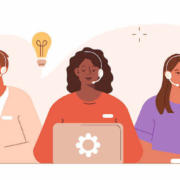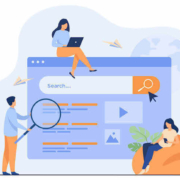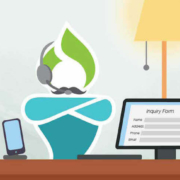Senior Living Lead Center Best Practices: What to Look For
/in Marketing Resources/by Debbie HowardLately, we’ve been talking about the fact that senior living communities don’t need call centers—they need lead centers.
Sure, twenty years ago, communities could get away with having “just” a call center.
Why? Well, people were still used to 9-5 mindsets for business hours. Digital marketing was in its infancy. Along with social media. Heck, back in 2003, many people didn’t have email addresses, and plenty of businesses didn’t have websites. (Or if they did, they were very basic.)
But everything has grown up and become more complex, including people’s expectations when they call a senior living community, no matter the time of day. If the person answering the phone isn’t equipped to answer the lead’s questions or book a tour, the lead is likely to dial on—quite literally.
That would really stink, wouldn’t it? Think of ALL the work (and money) that went into getting that lead to call in the first place . . . only to have the lead hang up in disgust, confusion, or both.
Now, we know what you might be thinking: Who cares if we miss a few phone calls? Most of the real action happens online anyway.
It’s easy to think that all marketing happens online. And while it’s true that most consumers’ journeys begin online, it’s also true that phone calls still have a place—especially in our industry.
In fact, did you know that 70% of senior services’ marketing leads are phone calls?
The problem is that too many of these valuable inbound calls are being handled by a receptionist or concierge whose job isn’t to qualify prospects. And/or the inbound calls are put on the shoulders of a call center that’s nothing more than a glorified answering service.
This is precisely why senior living communities need lead centers, not call centers.
And not just any company that calls itself a lead center, either. You need a lead center that can manage your inbound calls effectively and function as an extension of your sales team—one that’s literally “on call” during off-hours.
No easy task since most call centers that refer to themselves as lead centers aren’t.
So what should you do? How can you be sure you’re choosing a true senior living lead center?
Senior living lead center best practices.
Be on the lookout for the following best practices. If you hear the lead center’s sales reps talking about these things, you can feel confident that you’re in good hands.
The senior living lead center employs a team of experienced sales counselors to answer your community’s inbound calls.
The counselors have received training about the senior living industry and understand how emotional this call might be for some people.
They always treat callers with compassion and work hard at putting the caller into the appropriate lead-nurturing workflow. (For example, an adult child calling on behalf of a parent wouldn’t go into a workflow for someone inquiring about themselves.)
The senior living lead center’s counselors use your community’s discovery process.
Every community’s sales process is a little different, so it makes sense for the lead center to train counselors on the specifics of your discovery process.
- PRO TIP: Sharing your well-research buyer personas can be an excellent way to contribute to this important training.
The senior living lead center uses your CRM.
Again, the counselors from the lead center are an extension of your sales team. So they should feel comfortable learning and using your CRM. This is a must to ensure inbound callers don’t fall through the cracks.
The senior living lead center knows how to identify those callers who are ready for tours.
And best of all . . . the senior living lead center will go ahead and book these tours!
Over the years, we’ve listened in on SO many calls where the person answering the phone at the community cannot take care of this simple task. If someone calls wanting a tour—or if a tour is an obvious next step for the caller after asking them a few questions—then a tour should be booked ASAP.
This is often the first improvement you’ll notice after contracting with a good senior living lead center—you’ll see an increase in tours booked from phone calls.
Does this feel overwhelming?
Well, we’ve got some good news. We’ve created a next-generation senior living lead center called LeadGenie, and it does ALL of the above—and then some.
Best Content for Email Marketing to Baby Boomers
/in Marketing Resources/by Debbie HowardOver the last few years, we’ve talked a lot about marketing to baby boomers, and for good reason. The oldest boomers are turning 77 this year. The youngest boomers are turning 59. And all are strong candidates for various levels of senior living.
We’re just beginning to see the “gray wave” of baby boomers entering senior living, and it’s already creating record demand. This is one of the biggest reasons why the senior living industry is becoming so crowded—more and more operators are entering the fray so they can capitalize.
As marketers, it’s important to keep in mind what we know about this demographic. The majority have smartphones, use social media, and begin their buying journeys online. While people on the older end might share some of their parents’ and grandparents’ stoicism, they most certainly are not their parents or grandparents.
And the boomers on the younger end? They truly exemplify the “me generation” attitude of knowing what they want, when they want it, with very little patience for compromise.
This, of course, can create a conundrum for senior living marketers. Because competition is so fierce—and boomers’ desires are so specific—what you say and how you say it will matter more now than it ever has before.
Forget boring, generic marketing collateral—or marketing that’s too sunny and glowing. Boomers will see through that and quickly dismiss your brand.
What’s likely to resonate well with boomers will be a combination of the following:
- Authenticity. Does your brand sound real and relatable?
- Validation. Can you show that you understand what their needs are, their worries, their pain points, and their desires? (Sometimes being understood IS the goal; the boomers are perfectly capable of fixing problems on their own.)
- Surprise. Give them an honest take about your community that makes them sit up and pay attention.
This approach will work no matter what marketing vehicle we’re talking about—websites, social media, print ads, digital ads, video marketing, and, of course, email marketing.
Which brings us to the focus of this particular blog post.
How do you develop the best content for email marketing to boomers?
Below, we’re sharing ideas that can work in automated lead nurturing workflows, emails sent directly from sales reps, and community newsletters. What you use (and when) will depend on the goals and what you’re trying to accomplish.
Give them content they can’t find anywhere else.
This is good advice regardless of industry or persona. But when emailing boomers, it’s a must.
Don’t waste time sending them generic articles “about” senior living. Or how to evaluate senior living. Or what to look for in a senior living community. That stuff has been done to death. No doubt, you’ve likely covered some of these topics on your blog (which is OK).
You want to make the content in your emails so irresistible that they have no real choice but to click through.
Some quick-hitting examples:
- 10 dishes our chef made this week with veggies grown in our own garden
- Sunsets over [NAME OF YOUR COMMUNITY] – Real pics of gorgeous views captured by our resident photogs
- 3 things our resident action committee improved in our community in 2022
- How Ruth found unexpected romance with Tony
- Did you know? 25 fun, little-known facts about our community
- Signs that senior living isn’t the best fit for you
None of the above are things that someone can find anywhere else simply because the articles are specific to your community.
And notice how most of the topics deal with emotions. Emotions help push our logical brains into making buying decisions.
Not only that, but these topics hit on authenticity, validation, and/or surprise—those items we mentioned above that will resonate with boomers.
For example, if a divorced woman in her early 60s is wondering if it’s possible to meet someone special in your community, your article on Ruth and Tony might give them hope.
Or take the topic in the last bullet. That might feel like a risky topic. To do it right, you’ll need to be honest about who’s a good fit and who isn’t—and then offer up alternatives that may be a better fit.
If you truly understand the person you’re trying to attract to your community—and you know the traits and characteristics of someone who isn’t a good fit—why not be honest? It would be a waste of everyone’s time if your sales rep tried to woo someone who isn’t a good match for your community.
People reading an article like that will likely appreciate the transparency. And for those who ARE a good fit? Your honesty and transparency will help them trust you even more.
Or how about that topic talking about residents improving your community . . . another surprising, yet authentic topic. No community is going to be perfect, right? And no one reading the email expects it to be. So many folks are skeptical of advertising and marketing because of the “spin.” But an article that talks about how residents improved your community (which suggests it’s not perfect and/or there was something “wrong”) shows reality . . . but it also shows how that reality can change for the better.
Talk about a powerful selling point!
Share authentic slice-of-life vignettes. (Via videos, ideally.)
The videos don’t need to be professionally shot. In fact, we recommend avoiding videos that seem too slick or highly produced. A recording on a smartphone is fine.
- Share the spontaneous 30-second clip of the sing-along that broke out in the pub the other night that a resident captured on their phone.
- Do a time-lapse video of a resident completing an oil painting in the courtyard.
- Do a quick interview with the chef on the latest addition to the dinnertime menu.
- Share a video of residents with their cats, dogs, fish, or birds.
- Show the layout for a popular apartment—but show how different that layout looks based on the way 3 or 4 residents have their apartment decorated or set up.
Again, people won’t be able to find this content anywhere else. But it also shows REAL LIFE in your community. That’s the stuff people want to see because THAT’S the stuff that allows them to relate (or not) with the vibe.
Dig deeper into food-related content.
Listen, food matters. We don’t have to tell you that.
But it’s NOT enough to talk about the “delicious” food in your community or that everything is made from scratch. Most communities promote the heck out of those things already.
You need to dig much deeper with your food-based content.
Here’s a quick brainstorm . . .
- How do you support vegans, vegetarians, and gluten-free diets?
- Where are your ingredients sourced from—any special stories?
- How has the menu and dining experience evolved in your community over the years? (It’s OK if it has—talk about why! This will demonstrate that your community is nimble and responsive to feedback.)
- Talk about different approaches to meals in senior living communities in general, and why your community settled on its approach.
- Talk about relevant specifics that could influence a person’s decision—are there other options aside from communal dining?
- Can residents opt to have full kitchens (or not) in their homes?
- Do you have a registered dietitian on staff that residents can meet with?
- How do residents influence menu-making decisions?
- How are celebrations (resident birthdays/anniversaries) handled?
- Do you have something that truly differentiates your community from others in the area? Maybe you have a part-time sushi chef, or maybe you have a coffee house on-site that hosts karaoke, comedy nights, and poetry slams.
- Do a timelapse video of Sunday brunch.
- Do a closeup of menu production—how is it developed, who provides input, how is the physical menu created (do you include calories and nutritional information, for example)?
- Do fun surveys – the top three ways our residents like their eggs.
- Pancakes vs. French toast – what always wins in our community.
- Plant-based meats: How we’re incorporating this into our menus.
- Waste not, want not: Our approach to recycling and composting.
- A chef’s recipe and video demonstration of a current favorite dish or dessert among residents.
- Survey results on the top three favorite restaurants that residents like visiting in the area.
There’s no shortage of food-related content, and food is such a big part of everyone’s lives. Whether you’re doing lead nurturing, direct follow-up from sales, or newsletters . . . we can almost guarantee that an interesting food-based story will get clicked on.
Think of ways to tie email content into a fun offer.
For example . . . riffing off the survey results for the “top three favorite restaurants that residents like visiting in the area.” You could add an offer to this that says: “Book a tour with us by this date, and we’ll give you a $20 gift certificate to one of these restaurants.”
Do occasional picture-based emails.
We wouldn’t recommend only doing picture-based emails since this often requires an extra step on the recipient’s part if they have to tap/click to download the pics before they can view the email.
But occasionally providing an email filled with nothing but visual eye candy (with links to the complete story behind the photo) can be a great way to engage people and draw them to your site or social channels.
Reminders: email marketing best practices.
Pay attention to layout. Think bite-sized, mobile-friendly blurbs.
More and more emails will be read on mobile devices rather than desktops. You need short sentences and even shorter paragraphs. (Think fewer than 75 words in a single paragraph.)
Spend time on your subject lines.
Subject lines are arguably one of the most important elements in every email you send (if not THE most important). Don’t treat them as after-thoughts. Keep up with what’s working and what isn’t for subject lines. (We recommend following email marketing guru Jay Schwedelson.)
Experiment, conduct A/B tests, and do more of what works, but don’t become complacent, either. Because what worked six months ago might stop working (and that’s perfectly normal).
Pay attention to meaningful metrics.
Certain metrics, like open rates, continue to be a moving target thanks to changes companies make around data privacy. (We’re talking about you, Apple Mail Privacy Protection.)
This doesn’t mean you should stop paying attention to metrics and analytics. You’ll simply need to pay attention to different ones.
HubSpot has a good article on this topic, along with KPIs to focus on, including clicks and click-through rates, website traffic and leads, unsubscribes, and spam reports.
Basically, you WILL know if your email marketing is moving the needle and having an impact because you’ll see upticks in things like website traffic, leads, tour requests, and downloads. And, of course, with good marketing automation software, you’ll be able to drill down into each email you send to get nitty-gritty results on what content resonated.
Need help leveling up your email marketing?
We love working with clients on developing the best content for email marketing to boomers. Get in touch and let’s create a plan that gets the results you’ve been looking for.
Senior Living Website Design Best Practices
/in Marketing Resources/by Debbie HowardWe recently talked about how to create great copy for your senior living website. (Hint: It involves tapping into emotions.) But now let’s discuss senior living website design best practices.
Think of your website design as a supporting actor, not the lead.
People aren’t coming to your community’s website to see the design. They go to your site to learn about your community, to see if it stirs something inside of them, and to find answers to specific questions.
So again, think supporting actor, not the lead.
Don’t get us wrong, however. We’re not trying to diminish the design’s importance. The supporting actor in a film is still significant. And the same is true for the design of your senior living website.
The website’s design must . . .
- Guide the prospect where to go next
- Make it super obvious where everything is
- Be accessible to all people and across all devices
So how can you accomplish these things?
Keep reading.
Use real photos, not stock images.
Setting up professional photo shoots can be a pain in the butt—and a pricy one at that. We get it. But here’s the thing: While we do think a professional photoshoot is a worthwhile investment, especially for your senior living website design’s “foundational” images (like banner images on core pages), there’s nothing that says you can’t use photography from your staff’s smartphones to round out your efforts.
Yeah, yeah—blasphemy, right? Any designer reading this is likely cringing. But the reality is that today’s smartphones are capable of taking fabulous pictures, including ones that can work great on websites. (Remember, you don’t need the same high-resolution that you would for print materials.)
So if you truly want to elevate your community’s website, consider doing this: invest in staff training. Teach your marketing, sales, and activities teams how to take fabulous pics with their phones (a skill they can use and benefit from in real life, too).
Set up a team Dropbox that everyone has access to on their phone as well. Teach people how to take pics, do simple edits (like removing something from the background, getting rid of red eye, brightening a shot, etc.), and upload to Dropbox.
Then, your web designer should review everything regularly and keep the website updated with fresh shots. (Of course, marketing teams should also be paying attention to what’s in the Dropbox for social media, blog posts, downloads, etc.)
And remember to make this training part of the regular onboarding of anyone in marketing, sales, or activities.
A great place to start is with this guide from HubSpot: Phone Photography 101: How to Take Good Pictures With Your Mobile Device.
Bottom line: Thanks to today’s highly-advanced smartphones, there are ZERO reasons why any senior living website should still be using stock photography.
- PRO TIP: You might have heard rumors that Google penalizes sites for using stock images. This is false. As Search Engine Land notes in its interview with two Googlers, “Stock photography will not have a negative influence on web search performance for a webpage . . .” But that doesn’t mean using stock images is a smart strategy, especially for senior living communities, as we explained above.
Spend more time on your home page. (And don’t be afraid of experimenting with it.)
Your home page is arguably the most important page on your website. Even if people don’t enter your site via the home page, chances are good that they will navigate to it at some point.
The biggest challenge with the home page is that it needs to talk to everyone—and also one person specifically.
What do we mean by that? Well, your home page needs to speak to people who are at various points in their journeys.
Some folks might simply be learning about senior living. Others might be in a more urgent situation where they need to make a move within 30 to 60 days. Some might be looking on behalf of others (for example, an adult child looking on behalf of her mother). Prospective employees will land on the page as well. Some people will be visiting your home page for the first time while others will have visited a handful of times already.
Being all things to everybody—and yet still speaking to a specific person about their specific needs—is a balancing act, for sure.
One way for senior living communities to accomplish this is by helping site visitors immediately self-identify where they need to go next.
Create clearly labeled paths for people to follow. Good visuals can make all the difference. Maybe you include four nicely designed boxes in different colors right below the header image that speaks directly to your target personas:
- I’m learning about senior living options.
- I’m looking on behalf of a loved one.
- I’m interested in booking a tour.
- I’m interested in joining your team.
We’re riffing here, but you get the idea. Someone reading those options can self-identify and have a good sense of the information they’ll find when they click on the box that describes their situation.
Other important home page tips for senior living community websites:
- Use clear navigation. Don’t be coy or cute.
- If you use drop-downs, go big. Andy Crestodina from Orbit Media notes, “Little dropdowns create visual friction without much payback for the visitor. Big dropdowns (better known as mega menus) still have that bit of friction, but they offer so many options the UX benefits outweigh the cost.”
- Use real images of real people. See above. We can’t stress this point enough. And/or use real videos of real people.
Make your senior living website design accessible—to everyone.
This might mean overriding complaints from your web designer, depending on their personality. (Plenty of web designers do understand what we’re about to say, though.).
For example, if your designer feels a bigger font looks out of place with their design, but you know the bigger font is better for site visitors, well guess what? Go with the bigger font. If that means the designer needs to adjust their design to accommodate it, so be it.
Always err on the side of accessibility vs. aesthetics. (Honestly, an accessible site can still look amazing.)
Making a website accessible is the right thing to do. And, in many cases, it’s also the legal thing to do. Private businesses and nonprofits with 15 or more employees are subject to ADA website compliance guidelines. (That likely includes most—if not all—senior living communities.)
ADA stands for Americans with Disabilities Act. As marketing guru Neil Patel explains, ADA compliance is a process, not an overnight “fix.”
Things you need to think about:
- Font size and color contrasts (e.g., can people distinguish what’s a link vs. regular text?)
- Whether all photos have appropriate alt text
- Whether the site is easy to navigate with adaptive technologies (like screen readers)
And this is just the beginning.
Keep in mind that improving your website’s accessibility will help your target demo of older adults. For example, those bigger fonts and strong contrasts in colors will work well with aging eyes.
Learn more about the product we use to help our clients’ sites remain compliant and accessible to all.
Work with an agency that can help elevate your senior living website design.
At SLS, we appreciate a senior living website that’s accessible, aesthetically pleasing, and one hundred percent on brand. And more importantly, we know how to design sites that accomplish all three. Get in touch and let’s talk about how we can elevate your community’s website.
Further reading:
How to Create Great Content for Your Senior Living Website
/in Marketing Resources/by Debbie HowardIf you’re wondering how to create great content for your senior living website—meaning content that truly sets it apart from the competition and helps convert anonymous traffic into tours—then keep on reading.
Last fall, at SMASH 2022, I attended a great session called Consumer Neuroscience Insights: How Your Customers Make Their Purchasing Decisions Matters More than Ever. The session was presented by Peggy Scoggins, the founder of Adept Selling. Peggy did a phenomenal job. I found myself nodding throughout the entire 45 minutes.
Here’s the basic gist: When making a purchasing decision, consumers have to connect their “thinking” brain (the neocortex) with their emotional brain (the limbic system).
Peggy explained that decision-making is emotion validated by reason. In other words, prospects cannot make a decision based only on facts, reason, and intellectual validation. If they try, they’ll get stuck in the “not ready” stage because they haven’t connected emotionally with their decision yet.
And this is PRECISELY the problem we see with so many senior living websites. The copy is all about “just the facts, ma’am”—apartment layouts, lists of amenities, dinner menus. And, no—adding a cute pic of older people laughing on a garden bench won’t be enough to get that emotional brain going, either. The content needs to work MUCH harder at making the connection between facts and emotions.
So how do you accomplish this? Keep reading.
Think more heart, fewer facts.
On the surface, most senior living communities are selling the same thing: a place for an older adult to live a low-maintenance lifestyle with various levels of amenities and care baked in.
Apartment layouts, food options, types of activities—all senior living communities have those things. Those are the facts. You need to relate those facts to your ideal persona’s emotions.
This, of course, brings up some questions . . .
- How do you turn facts into emotions?
- How do you demonstrate what the facts can do for your prospect—make their life better, easier, happier, safer?
- How do you get prospects to feel something on every page of your site?
Simple. Through storytelling.
People LOVE good stories. They RESPOND to good stories. They REMEMBER good stories.
So the more compelling stories you can share, the better chance you’ll have at connecting the facts with the prospect’s emotions.
For example, let’s talk about the page on your website that talks about the activities your community offers. Giving a laundry list of activities—even if your list is three times longer than your nearest competitor’s—isn’t going to stand out. Yet that’s exactly what most senior living community websites do, more or less.
Sure, some sites will go the extra mile and make the page layout pretty in two or three columns. But a list is still a list whether it’s in one column or two or three.
Instead of a list, what if you led with three videos that tell engaging stories about the activities in your community?
- The first one could feature residents who participate in the weekly oil painting class.
- Another one could feature the community’s current pickleball champions.
- A third one could show a timelapse of a group outing to a local casino. You could intersperse mini-interviews from residents.
You get the idea. We’re talking videos of real residents doing real activities—and putting these videos front and center on the page on your site that talks about activities.
Yes, you can still have your list of activities on this page if you want.
But here’s a better idea…
In addition to the videos, maybe you create a nicely designed community activities guide that doesn’t just list the activities (the facts), but rather it brings emotion into the mix by interspersing short vignettes on various instructors, activity founders (like the book club, the garden club), and how often the activities take place. Maybe you include a feature on a resident who recently started a new activity (training to run their very first 5K, anyone?) and what the reaction has been like.
Imagine the prospect who visits that web page and downloads that guide.
Yes, they’ll see that see your community offers plenty of activities (the facts) just like every other community. But they’ll also experience some of the activities through storytelling. (Hello, emotions!)
Don’t shy away from tough topics.
Don’t get us wrong—we’re not suggesting you create a whole site (or even a section of your site) that’s all doom and gloom.
But sometimes creating a bit of cognitive dissonance in the reader is exactly how you can stir their emotions.
For example, make them a little uncomfortable about things that are likely already going through their heads, like the possible need for more care as they age. But then immediately reduce their discomfort by showing them that your community has a plan if they need more care. That’s the type of content that’s going to encourage the prospect reading the copy to let out a long overdue exhale.
And suddenly their emotional brain (“Ugh, I’ve been dreading making a decision because I was so worried about needing extra care someday; I’m relieved that this community has a plan”) aligns with the facts bubbling around in their thinking brain (“The location is close to my kids, the price is right, the reviews are good”).
Which, in turn, will help move them closer to a decision in your favor.
So, for example, let’s say a couple is looking to move into your continuing care retirement community (CCRC). But they wonder what will happen if one partner suddenly needs a lot more care. Would they be separated? Would the healthier partner have to upgrade to a level of care that he or she doesn’t need?
Your CCRC could discuss how it approaches these situations and it could share stories from people who’ve been in the same situation.
So what sort of “tough topics” should your community address on its website? That’s where knowing your personas inside and out will really make a difference.
Because topics will vary. What’s on the mind of folks entering an active adult community for people over 60 will be different from those who are shopping around for assisted living for themselves . . . or memory care for a parent.
Find out what those tough topics are. When addressing those topics on your site, includes facts, but also include plenty of warm and reassuring stories that demonstrate your community’s approach.
Remember that perfection is the enemy of good.
Since the dawn of the web, most businesses have approached a website launch or redesign as a standalone task, meaning once it’s done, they treat it as done forever.
But the reality is we need to think of websites like building a home. You don’t simply build it, move in, decorate it once, and that’s it. In a house, you make seasonal changes. You might buy some new pillows, simply because you love the color. You might bring in a vase filled with flowers to one room, rearrange the layout of another, and renovate the basement into a home theater.
The work in the home is ongoing.
The same is true for a senior living website. It should never be treated as done (even after a relaunch) because it never is done. And this is precisely why striving for perfection is a fool’s errand.
It’s OK if the copy, the videos, and the images aren’t perfect. (We’re not talking about the navigation, logo, and overall branding—those things must be polished and consistent.) But with storytelling, no one is expecting perfection. In fact, many of us are becoming skeptical of websites, marketing copy, and videos that are too slick, too polished, and too good to be true.
But a quick-hitting video of a yoga class where the instructor decided to bring in goats for a session is too good to pass up. Grab your phone and record. Even if it’s not perfect, THAT’S the sort of story that’s going to get reactions and stir people’s emotions.
I’d rather see a slightly shaky video of residents laughing their butts off during goat yoga than a highly-produced video showing off the gleaming hardwoods in the yoga studio. The former involves emotions. The latter involves facts. You need both, but you need emotions more.
Need help creating compelling website content that resonates with readers on an emotional level?
We take immense pride in our stable of talented content creators who know how to insert a good dose of heart into their copy (without sounding too sweet or sentimental). Get in touch and let’s talk about how we can elevate your website.
Advertising on Social Media: What to Keep in Mind
/in Marketing Resources/by Debbie HowardThere’s a reason why so many businesses are pouring money into social media advertising these days: It works.
Of course, the definition of “works” matters. Statista reminds us that “increased exposure” is the biggest benefit of social media marketing. In many ways, this makes perfect sense, right? Because increasing people’s awareness about a brand is what advertising is all about.
But like anything else, you need to be smart in your approach to social media advertising. Below, we’ll discuss several important tips to guide you on your journey.
Understand your goals—and know that they will (and should) change.
The more specific you can be about what you want to accomplish with your social media advertising, the better.
For example . . .
- Do you want to see a 5% increase in referral traffic to your website?
- Do you want to drive people to register for a webinar?
- Do you want to increase the number of followers by 10%?
Those are all specific, measurable goals.
Keep in mind that you’ll have different goals for different social media platforms—and possibly different goals for different campaigns within the same platform. For example, maybe you’re advertising on Facebook about a special in-person event for adult children to learn about your assisted living community. And maybe you’re also advertising your assisted living community to older adults with a spouse who could benefit from this level of care. Separate campaigns, separate goals, same platform.
Don’t pick the most popular social media platform. Pick the most popular platforms for your target audience.
Hopefully, you have solid buyer personas. If you do, you should have a sense of what social media platforms your buyers frequent. Remember, you want to focus on where they hang out rather than what’s popular.
For example, TikTok is wildly popular right now, but it also skews young. Oberlo reports that 92.39% of all TikTok users are aged 13 to 34. This doesn’t mean you won’t find some hip and savvy older adults on there. But by and large—right now, as we write this in early 2023—you’d likely be wasting dollars pouring ad spend into TikTok since it’s unlikely any of your potential buyers frequent that platform.
We understand that you might WANT to advertise on TikTok because it’s fun and the hot new thing, but it’s not going to give you the return on your investment that other platforms will.
Measure, measure, measure. (But be willing to experiment, too.)
Social media advertising is part art and part science. You could have a specific goal, a clear offer, and the right platform for your personas, but what ends up “working” and engaging people can sometimes be a surprise. That ad you spent a ton of time creating might not get the results you were expecting. And yet that video ad you posted on the fly delivers big time.
That’s OK! Because that, right there, is useful intel. See if you can spot trends or themes in the ads that deliver the results you’re looking for. For example, do you get better engagement when your video ads are under 30 seconds? Or do people like the ones that last a full minute?
Another important point: Social media advertising “success” is a moving target. What works this year might not work next year—or even six months from now.
Keep in mind that even though social media is all about immediacy, social media advertising is all about the long game.
Given how immediate social media is, it’s easy to think social media advertising will “work” just as quickly. And it’s true that you could run an ad that gets a ton of engagement all at once.
But that one-off bit of activity is not going to suddenly flood you with move-ins. It probably won’t even help you stay on people’s radars for very long since people’s attention spans are notoriously short. The adage about people needing to see or hear a brand’s message seven times (at least) still holds true, even when the message appears in an ad on social media.
Bottom line: Approach social media advertising with a long-term mindset, and plan for it like you do any other digital marketing tactic.
Get comfortable making videos. Lots of videos.
We can’t stress the importance of video creation enough—for all of your senior living marketing efforts. We’re not the only ones making this claim, either. HubSpot says that “consumers increasingly expect to see video content from brands.”
So what should you be doing? Well, everyone on your marketing and sales teams needs to get comfortable with producing videos from start to finish using their smartphones.
If that feels like a big ask, start by getting everyone to record short, raw footage—a quick hello from a resident, what’s on the lunch menu, etc. They can dump the footage into a shared Dropbox. Then, you can have someone on the team with video expertise (or hire an outside video pro) edit and post the videos. From there, you can use some of the more popular videos in your social media advertising.
Why video ads? Some studies suggest video ads perform better than image-based static ads. In fact, even studies that suggest the opposite still note that video ads work better in some cases, like with middle- and bottom-of-the-funnel folks who are already familiar with your brand.
If you’re going to do social media advertising right, you’ll want to have a good mix of static ads and video ads. And, of course, you’ll want to test everything while monitoring engagement and conversions.
Don’t go it alone! We can help.
We have paid search and social media specialists on staff who can help you take your digital advertising to the next level. Get in touch and let’s chat!
Paid Search vs. Organic Search for Senior Living Lead Generation
/in Marketing Resources/by Debbie HowardIf boosting senior living lead generation is your main objective, you might be wondering which tactic is better: paid search or organic search. Like most things in life, the answer isn’t clear-cut. Both tactics have merits.
Below, we’ll discuss the following:
- Definition of paid search and organic search
- The benefits of paid search and organic search
- Challenges associated with each
- How both can affect your lead generation efforts
What is paid search?
When people go to a search engine like Google, they type in their query (e.g., “senior living communities near me”) the search engine produces the “search engine results page” (the SERP). At the top of this page, you’ll see paid listings followed by organic listings.
With paid search, you pay the search engine to display your ads at the top of the SERP. You choose the search terms (the keywords) that you want your ad to show up for. As Google explains, you’ll only be charged when someone clicks on the ad. (This is a simplified explanation, of course!)
Some keywords are more competitive than others, and you need to compete with other businesses for them by bidding and winning an auction. As Google notes: “The exact prices are determined by how many other businesses are bidding on the same keywords.”
That gives you the general gist. As its name suggests, paid search is a pay-to-play scenario.
Now, let’s discuss organic search.
What is organic search?
As the name suggests, organic search results are the “natural” or unpaid listings on the search engine results page (SERP).
In other words, you don’t pay to have your site show up on the SERP. It happens naturally because the Google algorithm has deemed a particular web page from your site as highly relevant to the searcher’s query.
How do you get your website pages and blog posts to show up in organic searches? By optimizing them. This is referred to as SEO, or search engine optimization.
SEO involves both on-page and off-page tactics. On-page elements include things like writing compelling content around specific keyword phrases. Off-page elements include things like how fast pages load and whether the site is mobile-friendly.
Again, we’ve simplified this explanation. You can read more about SEO for senior living here.
What are the benefits of paid search?
Increases visibility
People pay attention to what shows up on the first page of Google, which is where those all-important paid ads are located. In fact, according to marketing wizard Neil Patel, 75% of people will never scroll past the first page of Google results.
Boosts brand awareness
A popular tactic with paid searches is making sure your ads come up when people google your competitors’ names. Someone googling a competitor might be looking for something specific, like a phone number to reach a resident. But some folks might be googling because they heard about the community, and they’re interested in touring. (Meaning they’re a good prospect for your community!)
Here’s the thing: If your ad comes up when they google the other community’s name, their eyes will see your ad. They might not act on it. They might not even be aware they’re seeing it. But your name will register on a subliminal level. And if they DO notice your ad, they might click it instead of going to the competitor’s site.
Can quickly drive traffic to your website
Paid search, when done right, can drive traffic to your site quickly. Which is the point. The “done right” part is critical—and one of the inherent challenges (more on this below).
What are the benefits of organic search?
Cost-effective
Yes, it takes work to optimize your website. And you’ll need someone to do the work, whether a staff member or an outsourced marketing agency like ours. And while SEO is never truly done . . . if you’ve optimized your website and you do a good job of optimizing all new content that you publish (like blog posts), it will likely be a more cost-effective strategy in the long run.
A preferred option for some searchers
Not everyone trusts or pays attention to ads. In fact, according to End Point Digital, “70-80% of all searchers ignore paid ads and focus on organic results only.”
With effort, you could outrank competitors—naturally
Again, optimizing your site for organic search is a marathon, not a sprint. But if you put the time and effort in, the work can pay off by outranking your competitors in the organic search listings for a variety of competitive and long-tail keyword phrases.
Helps build website authority and brand authority
The more web pages and blog posts that rank well in Google, the better overall authority your website will have—which can further boost newer pages and blog posts. It’s a positive domino effect.
Challenges associated with paid search & organic search
The biggest challenge for one tends to be an advantage for the other.
For paid search, the biggest challenge is usually budget. You need to pay to play—and often you need to pay big dollars to get the momentum and ROI you’re looking for. You also need to pay someone to manage your ad campaigns. (We don’t recommend setting them and forgetting them.)
Organic search optimization requires someone to do the optimization work. So there is an initial cost (and that’s true whether you use a staff member or outsource to an agency like ours). But if you’ve done a good job optimizing your web pages and posts, they will continue to work on your behalf—even if you don’t invest much in them moving forward.
For organic search, time is the bigger issue. You need to devote a lot of time to optimizing your site. Not to mention, it can take time for pages to rank. On the flip side, with paid search, you could set up a campaign today and see traffic to your site right away.
Which one should you use for your senior living lead generation efforts?
Like all things in life and in marketing—it depends.
Things to consider include the following:
- ROI and budget. In order to figure out ROI, you need to understand the total revenue generated by a customer (in senior living, it’s a resident, and that total revenue can come in over months or years). When you know that number, you can justify (or not) budgets and costs for paid search vs. organic search.
- Time. Do you have the time, staff, and expertise to work on optimization? Do you have the budget to farm out this work—perhaps in addition to running paid search ads?
- Immediate goals. If you’re looking to drive traffic to something specific and perhaps urgent—for example, the opening of a new community or a time-sensitive event at your community—running a highly-targeted ad campaign could make sense. If you’re looking to bolster brand awareness, especially against your competitors, a paid ad campaign would also make sense.
Usually, we don’t recommend one over the other. With most of our clients, we work on ongoing organic search optimization—which should be happening whether you run paid ads or not. Then, if it makes sense for the client’s budget and goals, we build out specific paid campaigns.
Keep in mind that paid search isn’t the only “pay to play” game in town. Paid social media advertising is another tactic, one that can be used instead of or in addition to paid search ads.
Is your head spinning? We can help.
Maybe you’re overwhelmed by everything we wrote above. Or maybe you simply want a fresh take on your current paid ads and organic search efforts. Either way, we can help! We have paid search and SEO specialists on our team who can work magic on your campaigns and organic search results. Get in touch and let’s talk.
How to Choose a Senior Living Call Center: 5 Questions to Ask
/in Marketing Resources/by Debbie HowardWondering how to choose a senior living call center? Here are 5 important questions to ask—and what you should look for in the answers.
1. Are you locked into an annual contract?
Annual contracts stink. Why should you be locked into a whole year? Or be required to pay a penalty if you break the contract because you’re not happy with the service?
Being able to pay as you go makes more sense for everyone, including the call center. How so? Well, if you could conceivably cancel at any time, the call center will be much more motivated to deliver superior service every day. This great service will make you a happy customer. Happy customers become loyal customers and good sources of referrals (which will make the call center happy).
2. What sort of training does the call center provide?
Call center staff should receive training about the senior living industry in general and your community in particular.
Ideally, you’d want to work with a call center that specializes in senior living. This way, the call center staff will already be ahead of the curve since they’ll have an understanding of things like . . .
- Different types of senior living lifestyles. Think independent living, assisted living, memory care, active adult, and so forth.
- Questions that will help uncover a caller’s immediate needs. Is the caller interested in booking a tour? Do they have questions about amenities? The call center staff should be able to address these questions.
- How to properly represent your brand and the senior living industry. Remember, the caller isn’t going to know they’ve reached a third-party service. The caller will assume the person answering their calls is part of your community.
3. Is it “just” a call center—or does the call center offer a true lead management solution?
There’s nothing wrong with “just” a call center. But if you’re going to make this investment, wouldn’t it make sense for the call center staff to do more than simply act as a glorified answering service?
Think about why you’re considering a call center in the first place. You probably suspect something’s “off” with your current sales process when potential leads call your community. You might not know exactly where things fall apart, but you know it starts when a prospect calls, especially after hours.
If this is the case, you don’t need “just” an answering service. You need a lead management solution, one where the call center staff can answer specific questions about your community, properly qualify callers, and funnel them into the right channels for follow-up and further communications.
For example, is the caller ready for an immediate sales interaction? Or are they still in the early stages and would benefit from email nurturing? Does the call center staff have experience with your senior living CRM so that they can properly score the lead and enter the person into the appropriate next stage for follow-up?
Bottom line: If what you need is a true lead management solution, then the senior living call center should seamlessly become an extension of your sales and marketing teams. And not every call center is capable of doing that, which is precisely why you need to ask.
4. Does the call center meet and/or comply with regulatory requirements?
Compliance matters! You want to use a provider that meets regulatory requirements, such as HIPAA, TCPA, and various federal, state, and local consumer privacy laws (like CCPA) while recording up to 100% of interactions in a fully-compliant manner.
When vetting call centers, ask about things like . . .
- Encryption
- Automated and on-demand masking
- Consent-based recording
- Retention options
5. How’s the call center’s uptime?
You’re paying a senior living call center to TAKE CALLS, not lose them. Look for a provider that can offer a high-reliability environment with 99% uptime and no actual downtime for maintenance windows.
Your call center should never lose a call or session due to the center’s infrastructure going down, and there should never be any disruption of active or queued sessions or calls.
Need a recommendation? Say hello to LeadGenie!
We’re proud to offer LeadGenie. It’s more than a call center, it’s our senior living contact center solution. Check out the LeadGenie website to learn more!
Organic Search Visibility: Think Beyond Your Website
/in Marketing Resources/by Debbie HowardOptimizing your senior living website is an excellent first step if you want to improve your community’s organic search visibility. But you also need to think beyond your website. Here are three ways to do exactly that.
1. Optimize your Google Business Profile.
Previously known as “Google My Business,” your Google Business Profile is exactly as it sounds—a profile of your business. Or in this case, a profile of your senior living community. (And yes, if you have multiple locations, you should claim your Google Business Profile for each location.)
Your Google Business Profile essentially acts as its own mini website. And since Google dominates the search market, you must pay attention to it.
The good news? Your Google Business Profile is free. And the interface is easy to use. Best of all, people pay attention to these profiles when they search on Google since business profiles are prominently displayed on the screen. The profile shows key information—address, phone number, hours of operation, and reviews—all in one place.
Here’s the thing: If you have a business, especially one in a physical location, your profile already exists (and sometimes with inaccurate information). This is why it’s essential that you claim your profile, double-check all info, and spruce it up to make it as appealing as possible.
And trust us: All of these efforts will pay off. Your Google Business Profile is tied closely to Google’s local search algorithm, which pays attention to a searcher’s physical location. (If you’ve ever done a search in Google and ended your search query with “near me,” like “Mexican restaurants near me” or “movie theaters near me,” you get the idea.)
Check out this article we wrote that takes a deeper dive into Google Business Profiles, including tips for keeping the content fresh and engaging.
2. Create and maintain an optimized YouTube channel.
Remember who owns YouTube: Google. So it’s no surprise that YouTube videos show up in Google’s organic search results. Not to mention that YouTube is the most viewed site globally, and the second most viewed site in the U.S. (Google is first).
Now, we’re not going to lie: Having a YouTube channel is a long-term strategy. You can’t simply start a YouTube channel tomorrow, post a couple of videos, and voila. (That’s why our tip says to “create and maintain” your channel).
However, if you consistently make helpful videos around keyword phrases that your buyer personas are searching on (especially long-tail keyword phrases), over time, this work will pay off by boosting your organic search visibility.
The best part is that you can repurpose your videos. Embed them into blog posts and lead nurturing emails. Share them on social media. Use them in advertising.
Your videos don’t need to be professionally shot, either. If you have a smartphone, a ring light, and a lavalier microphone, you can make professional-looking videos with free apps like InShot.
Wondering what sort of videos to make? Check out our article about YouTube content ideas. And check out marketing wizard Neil Patel’s article on the YouTube search algorithm.
3. Run Google Ads campaigns.
OK, we know what you’re thinking: Isn’t this supposed to be a blog post about improving organic search visibility? What does a Google Ads campaign have to do with organic search results?
First of all, a lot, thanks to Google. When you do a search in Google, paid ads show up before organic search results. (Go ahead and do a search on “senior living communities near me.” Notice the placement of the paid ads.)
Even if someone scrolls past the ads, their brain can’t unsee things. And it’s amazing how simply seeing the name of your community in a paid ad can reinforce the organic listing. It’s all about name recognition.
Bottom line: Running Google Ads campaigns is a smart strategy for boosting your overall exposure and improving your organic search visibility. (Running ads on Google’s Display Network is another excellent way to boost awareness. Those are the ads that “follow” you around on various websites.)
Need help improving your organic search visibility?
We understand that our suggestions above might sound good. But who’s got the time to execute these tactics when you’re already juggling ten million other things? Let us help. Our team can serve as an extension of your marketing department. Let’s talk!
Introducing LeadGenie: Our Answer to the Senior Living Lead Management Conundrum
/in Marketing Resources/by Debbie HowardWhen you hear the words “senior living lead management solution,” does “call center” come to mind?
Do you picture a sterile environment that’s far removed from your community with uninterested workers watching the clock—and that’s only when they’re not fumbling their way through generic scripts during calls?
No doubt, most of us can probably relate to Kieran Culkin’s frustration with call centers as demonstrated in this Saturday Night Live skit:
Here’s the thing, though: lead management solutions are not like that, provided they’re set up correctly and staffed with people who’ve been trained properly.
-
- A good lead management solution can take the pressure off receptionists and front office staff who were hired to engage with residents and visitors, not field sales questions.
- A good lead management solution can take the load off sales teams stretched too thin. It’s not the best use of your sales team’s time to qualify early-stage leads. Salespeople should be focusing on high-intent leads rather than leads that are at the top of the sales funnel.
- A good lead management solution can help you “win” with third-party leads. Since third-party leads are shared leads, the only way you can win is to be first and persistent.
The problem is that too many lead management call centers haven’t been set up in a thoughtful manner and with staff members who’ve received the requisite training to do an excellent job.
Until now.
We decided that we wanted to turn senior living lead management on its head. The result is LeadGenie from Senior Living SMART.
Read more: Visit the LeadGenie site!
LeadGenie is the senior living lead management solution you’ve been waiting for.
LeadGenie as a complete lead management solution that goes beyond a call center. With LeadGenie, you get . . .
- Virtual Sales Support. Your sales team can focus on high-intent leads while your LeadGenie team manages the rest.
- Augmented Sales Staffing. This is ideal for shared markets—you’ll have a centralized sales hub.
- Reduced Overhead Costs. You could save as much as $24K a year in some cases.
- Better Turnover Management. No more panicking when one of your salespeople resigns or needs to take a leave of absence.
- Virtual Front Desk Support. Avoid bottlenecking sales leads thanks to our dedicated sales response staff—a staff that we train and who know how to draw out relevant info from prospects for future nurturing.
- Speed to the Lead. LeadGenie provides the quick, persistent responses required to win at the third-party lead generation game.
We customize LeadGenie to your community’s specific needs and sales challenges.
One of the biggest problems with other senior living lead management solutions is they tend to be one-size-fits-all. But your community’s challenges aren’t necessarily the same as another community’s. So shouldn’t the “solution” be different?
We think so, which is why we customize your LeadGenie solution to your community’s specific sales challenges. We do this by understanding your current lead volume, conversions, and the tools you use.
Don’t worry—we won’t try to upsell you on new software. Our job isn’t to reinvent the wheel. Rather, we focus on getting the most out of your existing tools and software, streamlining and improving workflows, and taking the pressure off your staff so they can focus on their jobs.
Plus, you don’t need to sign a 12-month contract like you do with so many other lead management solutions and call centers. Bottom line: You have nothing to lose and everything to gain with LeadGenie.
Learn more about LeadGenie from Senior Living SMART.
Are you intrigued by our answer to the senior living lead management conundrum? Visit the LeadGenie website to learn more and to schedule a no-obligation consult. Here’s to better leads!
Senior Living SMART
225 Water Street
Suite A110
Plymouth, MA 02360
888–620–9832
[email protected]
Popular Services
SMARTNews Signup
Sign up for our newsletter and stay up to date with the latest information on industry news.











